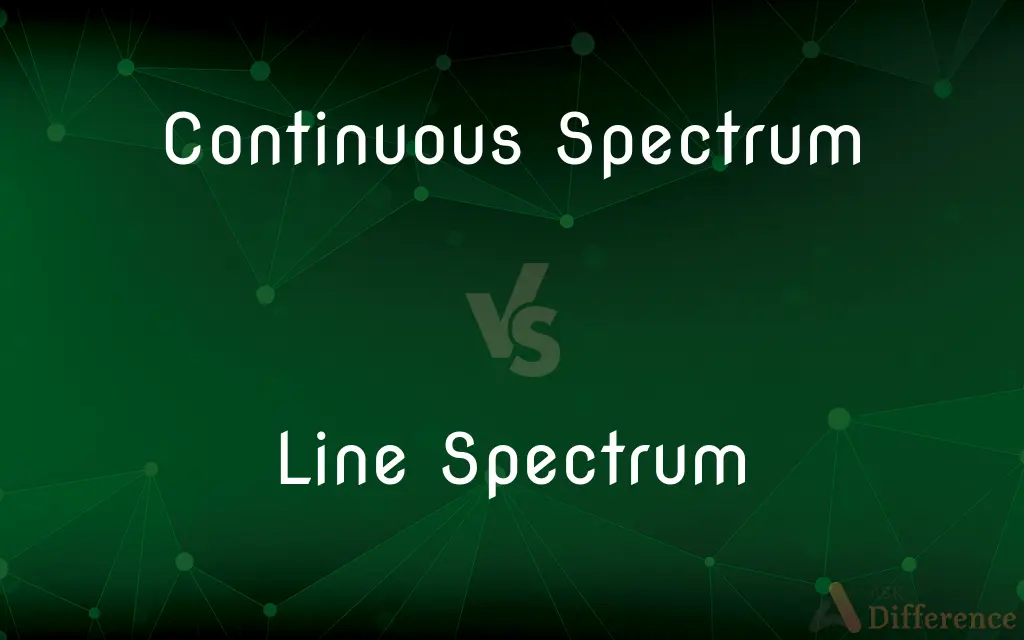Continuous Spectrum vs. Line Spectrum — What's the Difference?
By Tayyaba Rehman — Published on November 28, 2023
Continuous Spectrum displays all wavelengths of light, while Line Spectrum shows only specific wavelengths, appearing as discrete lines.

Difference Between Continuous Spectrum and Line Spectrum
Table of Contents
ADVERTISEMENT
Key Differences
A Continuous Spectrum showcases a seamless, uninterrupted range of colors or wavelengths, usually displaying all the visible colors without any separation or specific, isolated wavelengths. This phenomenon is often seen in circumstances where a wide range of wavelengths is emitted or transmitted, such as the light from a heated solid object. The Continuous Spectrum therefore becomes a vast, uninterrupted sweep of various colors, without any clear demarcation or separation between different wavelengths, presenting a continuous spread from one end of the spectrum to the other.
In stark contrast, a Line Spectrum is characterized by its display of only specific, discrete wavelengths or colors, often appearing as distinct lines against a dark background. The Line Spectrum emerges typically when a gas is heated or when atoms are otherwise excited, causing them to emit light at particular wavelengths. This selectivity in emitted light is indicative of the unique energy levels within atoms, providing a spectral signature that is inherently specific to the element or compound emitting the light, thus providing a kind of chemical fingerprint through its Line Spectrum.
Delving further into the Continuous Spectrum, it is significant to highlight that this encompassing range of wavelengths doesn’t exhibit any gaps or dark lines. In scenarios such as white light dispersion through a prism, a Continuous Spectrum is witnessed as the light is split into its constituent colors, showcasing a gradual transition from one color to another. This can be particularly elucidative of the wide-ranging wavelengths present in the incident light, offering insights into its composition.
When exploring the Line Spectrum, the discrete lines are notably aligned with transitions between energy levels within atoms. When an electron transitions from a higher to a lower energy level, a photon is emitted, and its energy corresponds to a specific wavelength of light, which is reflected as a line in the Line Spectrum. This direct correspondence between line position and energy differences can be instrumentally vital in deducing elemental compositions and electronic structures of atoms in a given sample.
It is vital to denote that while the Continuous Spectrum provides a broad-spectrum view of all present wavelengths, the Line Spectrum serves a unique purpose in qualitative analysis. Line Spectra, with their specificity, enable the identification of elements in distant stars, as well as facilitate understanding of atomic structure and electron transitions, serving critical roles in fields like astronomy, chemistry, and physics.
ADVERTISEMENT
Comparison Chart
Wavelength Representation
All wavelengths presented
Specific wavelengths only
Emission Source
Often from heated solid
Typically from excited gas
Use in Analysis
General color/wavelength info
Identification of elements
Appearance
Unbroken, smooth transition
Discrete lines
Relation to Energy Levels
Not directly related
Directly related
Compare with Definitions
Continuous Spectrum
Can be observed via prism dispersion.
White light through a prism reveals a Continuous Spectrum.
Line Spectrum
Displays select wavelengths.
A neon light generates a Line Spectrum.
Continuous Spectrum
Emitted from hot solids.
A heated iron rod emits a Continuous Spectrum.
Line Spectrum
Appears as discrete colored lines.
In a Line Spectrum, distinct, isolated colored lines are observable.
Continuous Spectrum
Inclusive of all visible colors.
The rainbow displays a Continuous Spectrum.
Line Spectrum
Represents atomic energy transitions.
The Line Spectrum of an element illustrates electron jumps.
Continuous Spectrum
No dark lines or gaps.
A Continuous Spectrum from a light bulb lacks dark bands.
Line Spectrum
Emitted from excited gases.
Hydrogen gas, when excited, reveals a unique Line Spectrum.
Continuous Spectrum
Smooth transition between colors.
The Continuous Spectrum in a rainbow has no abrupt color changes.
Line Spectrum
Used to identify elements.
The Line Spectrum can be used to ascertain chemical compositions.
Common Curiosities
What information can a Line Spectrum provide?
It can identify elements and provide information about atomic energy levels.
How is a Line Spectrum generated?
By the emission of light at specific wavelengths from excited atoms.
How is a Continuous Spectrum formed through a prism?
By dispersing white light, splitting it into its constituent colors.
What does a Continuous Spectrum display?
It shows all possible colors or wavelengths without gaps.
Are all colors visible in a Continuous Spectrum?
Yes, it typically displays a smooth transition of all visible colors.
Can Line Spectrum appear in a Continuous Spectrum?
Absorption lines can appear in a Continuous Spectrum, revealing specific absorbed wavelengths.
Is there any break in the Continuous Spectrum?
No, it displays an unbroken range of colors.
Can a Continuous Spectrum appear in nature?
Yes, phenomena like rainbows exhibit a Continuous Spectrum.
Can Line Spectrum help in astronomical studies?
Yes, it aids in identifying elements in stars and galaxies.
Why do different elements show different Line Spectra?
Different elements have unique energy level structures, affecting emitted light.
How does heating impact the Continuous Spectrum?
Heated objects can emit a wide range of light wavelengths, creating a Continuous Spectrum.
Can Continuous Spectrum identify elements?
No, it doesn’t provide specific elemental information.
Is the Line Spectrum useful in chemical analysis?
Yes, it’s pivotal in identifying and analyzing elemental composition.
Can Line Spectrum indicate electron transitions?
Yes, the lines correspond to specific electronic energy level transitions.
How does Continuous Spectrum differ visually from Line Spectrum?
Continuous Spectrum shows an unbroken range of colors, while Line Spectrum shows isolated lines.
Share Your Discovery

Previous Comparison
Brown Sugar vs. Molasses
Next Comparison
Pitcher Plant vs. Venus FlytrapAuthor Spotlight
Written by
Tayyaba RehmanTayyaba Rehman is a distinguished writer, currently serving as a primary contributor to askdifference.com. As a researcher in semantics and etymology, Tayyaba's passion for the complexity of languages and their distinctions has found a perfect home on the platform. Tayyaba delves into the intricacies of language, distinguishing between commonly confused words and phrases, thereby providing clarity for readers worldwide.
















































